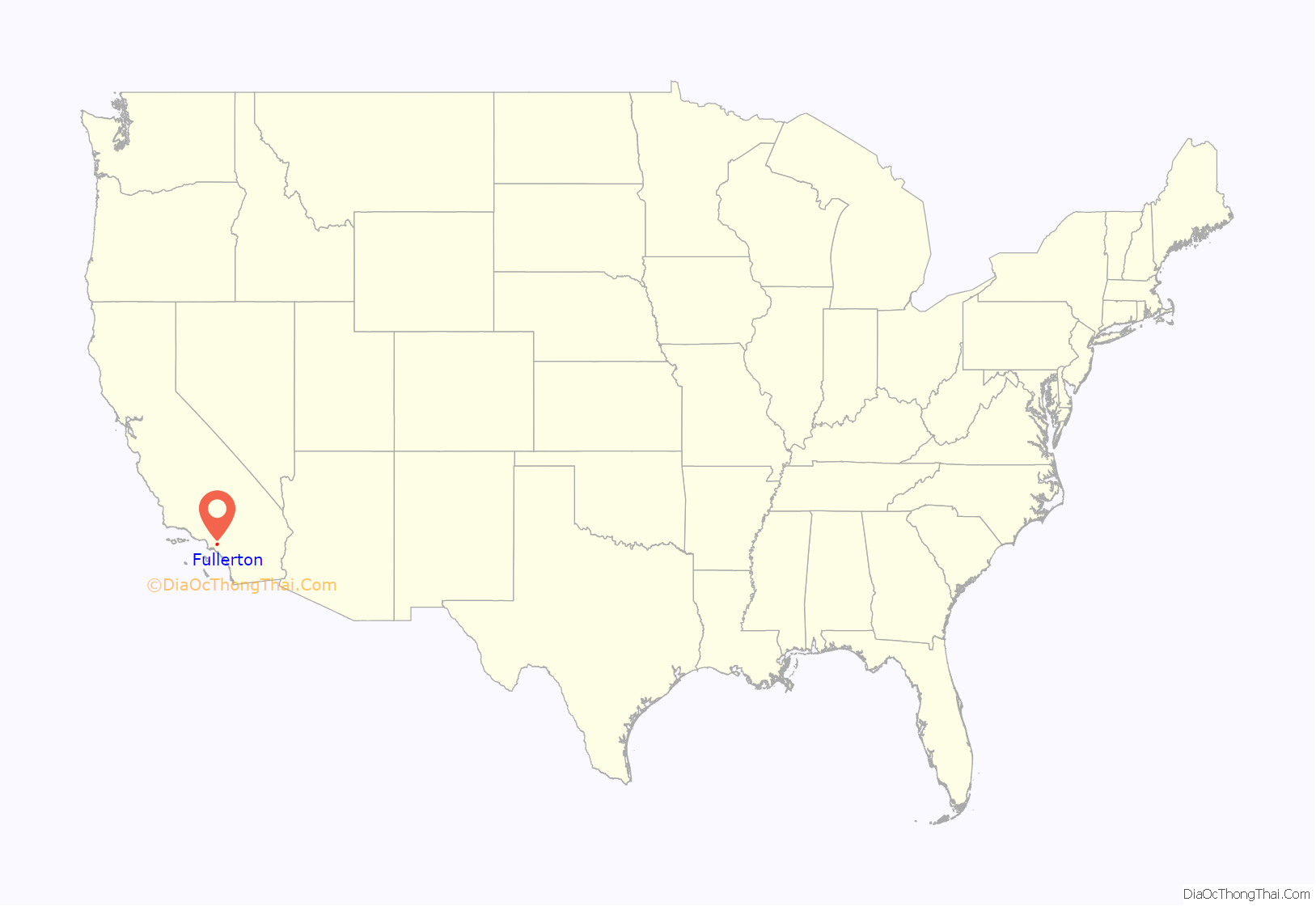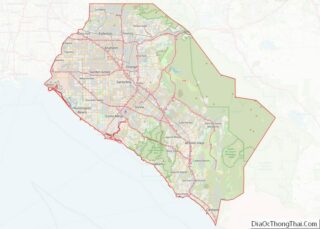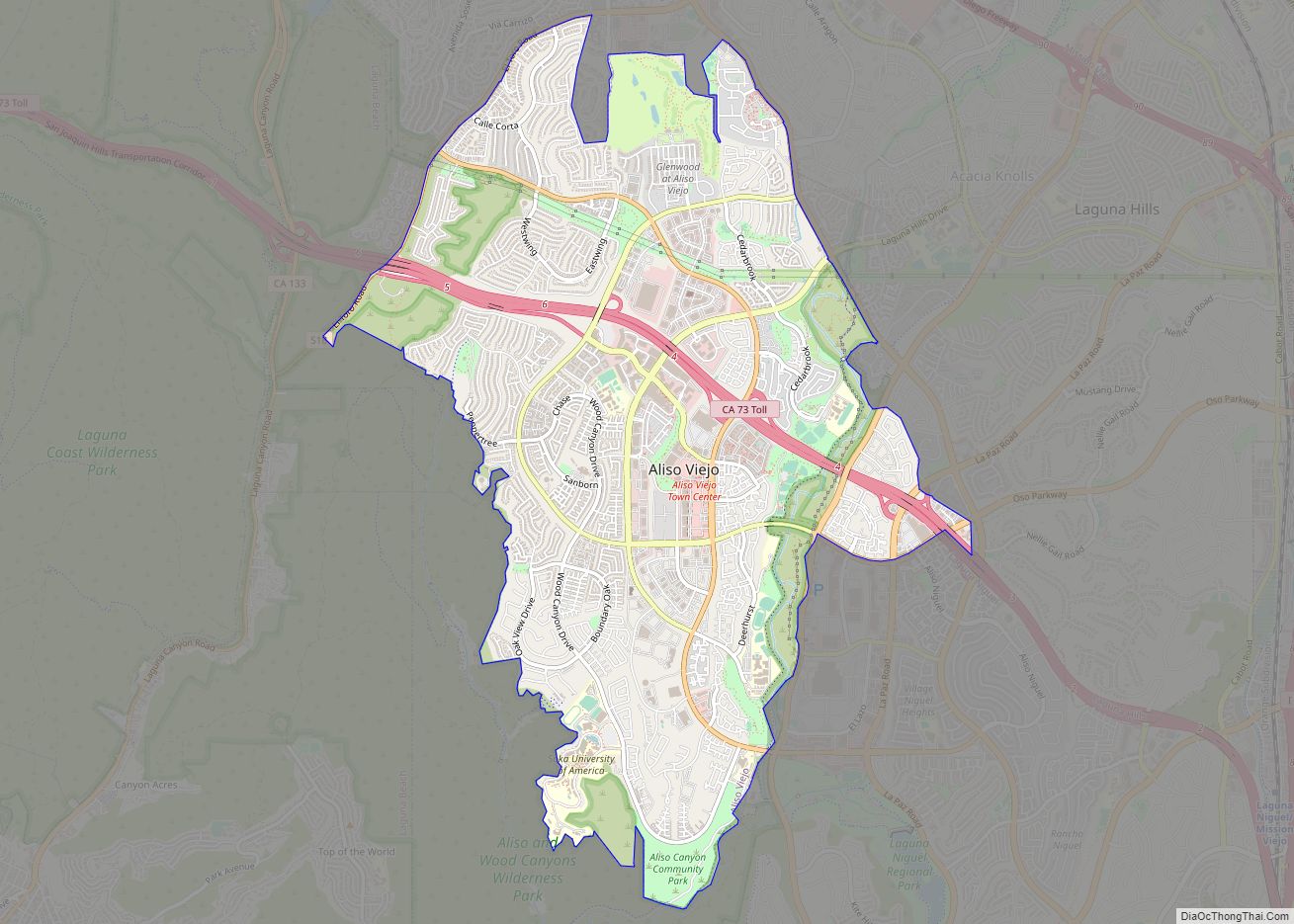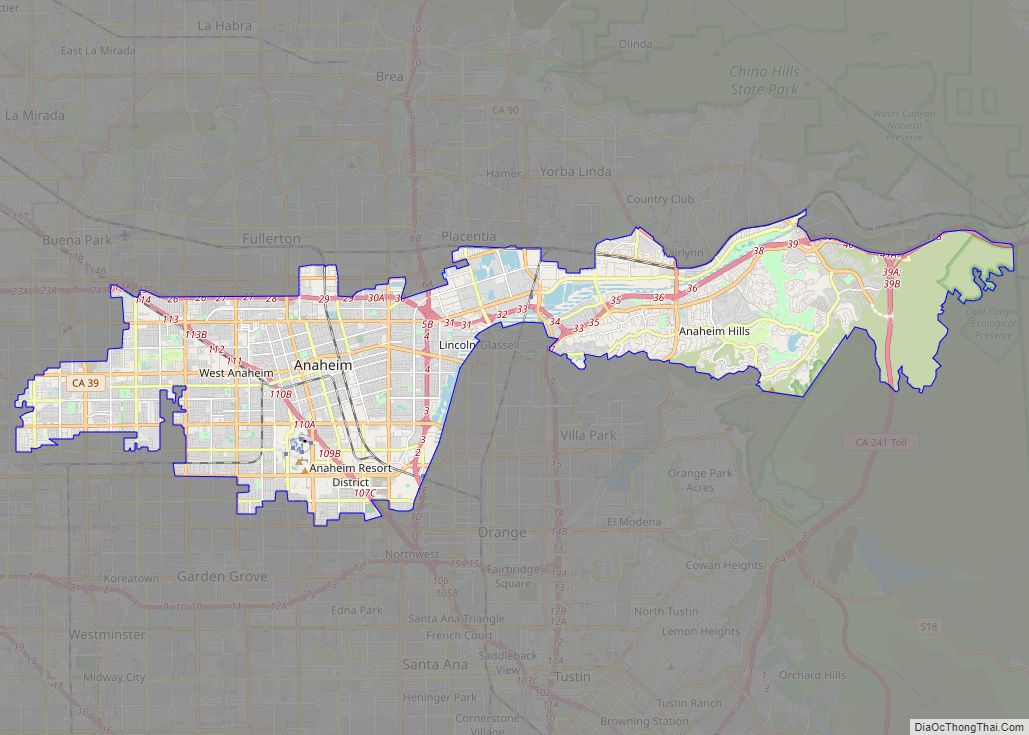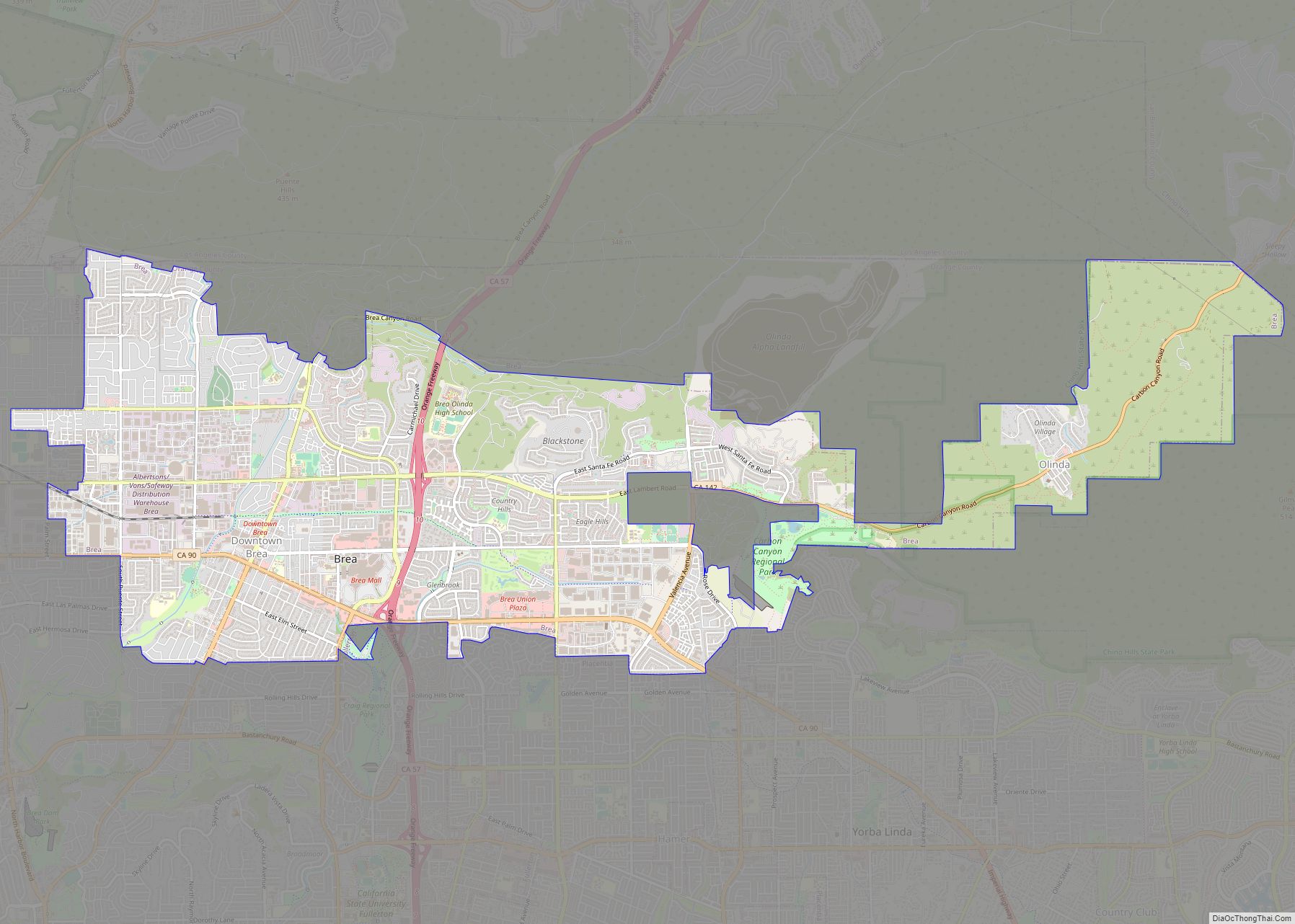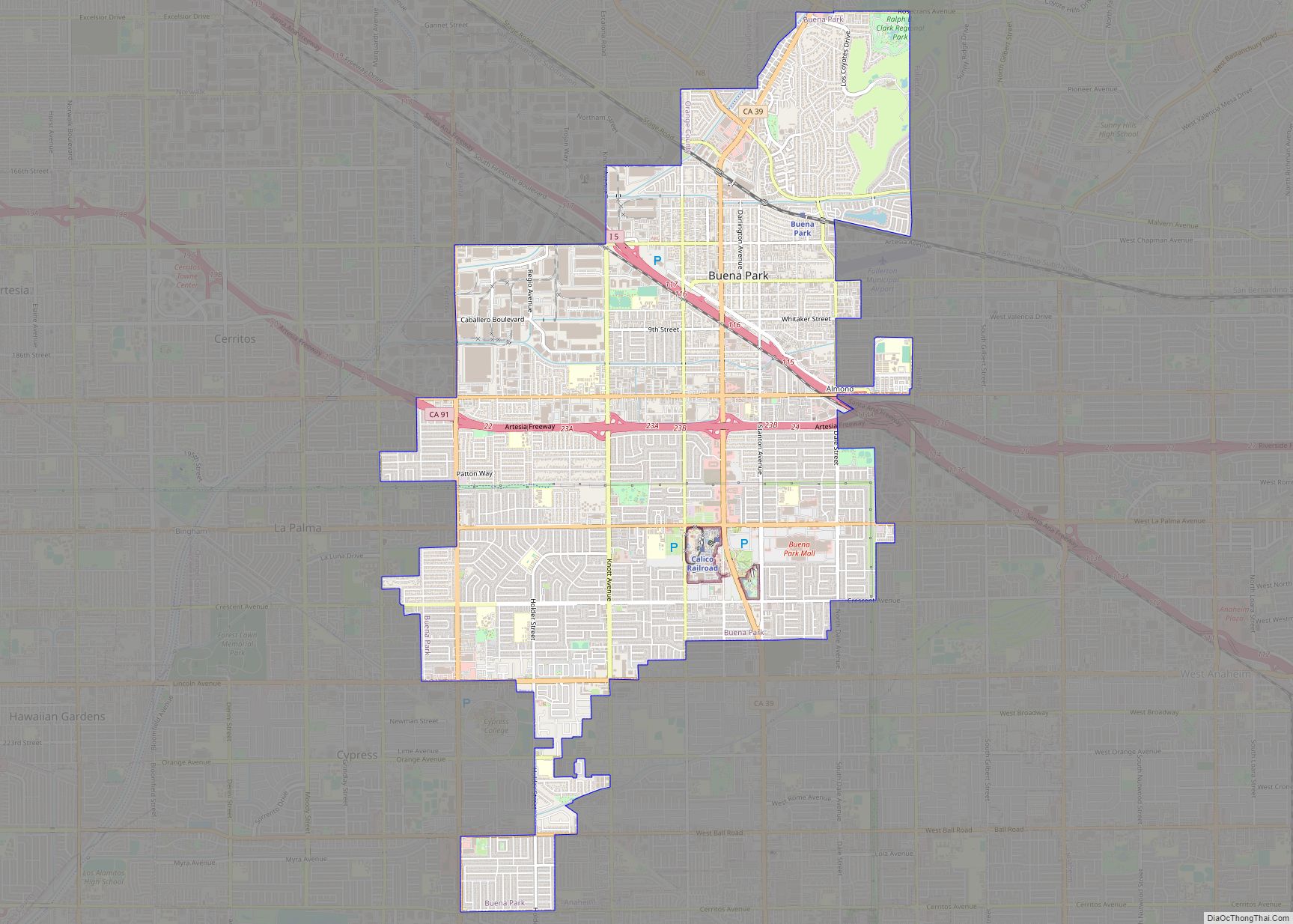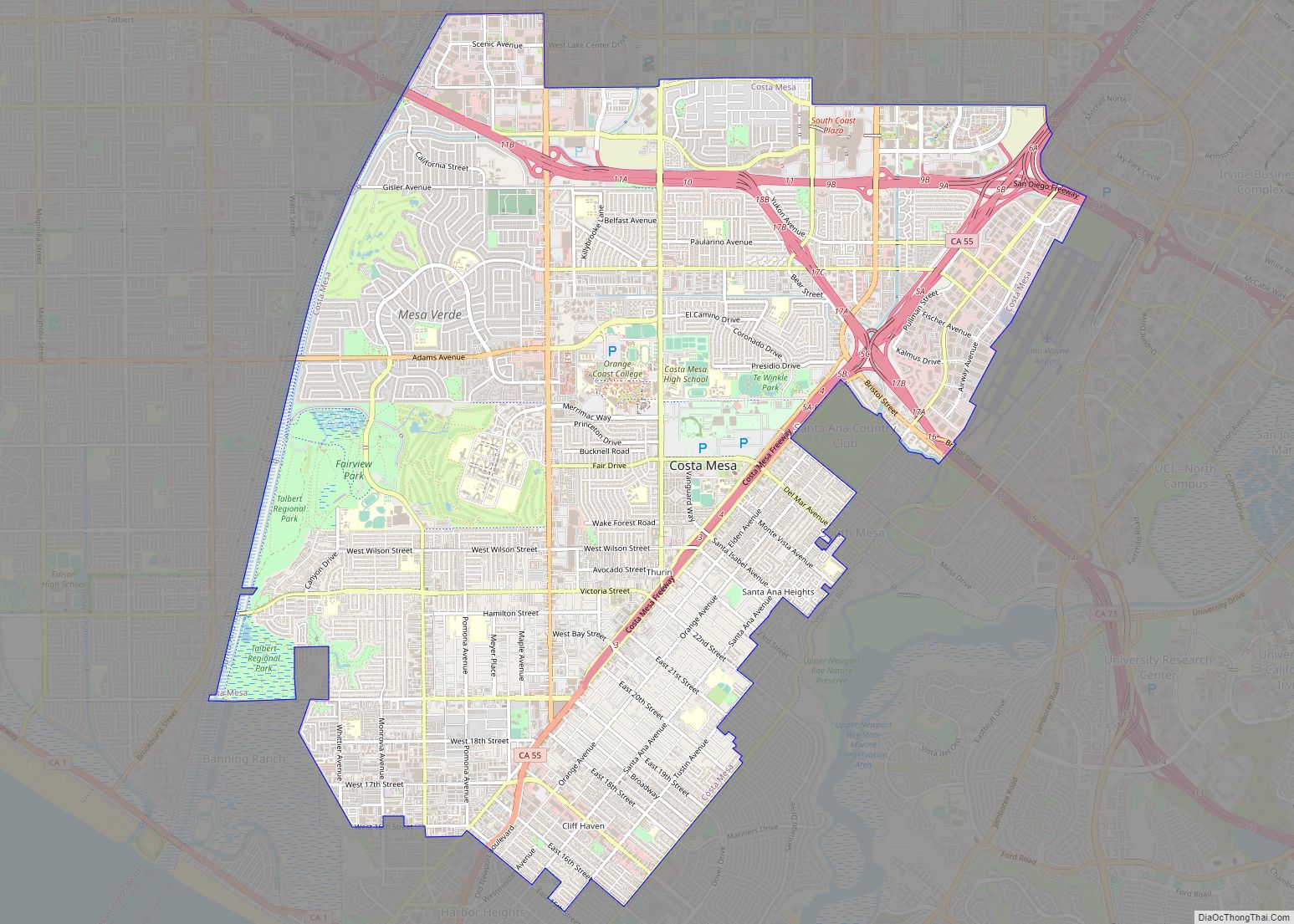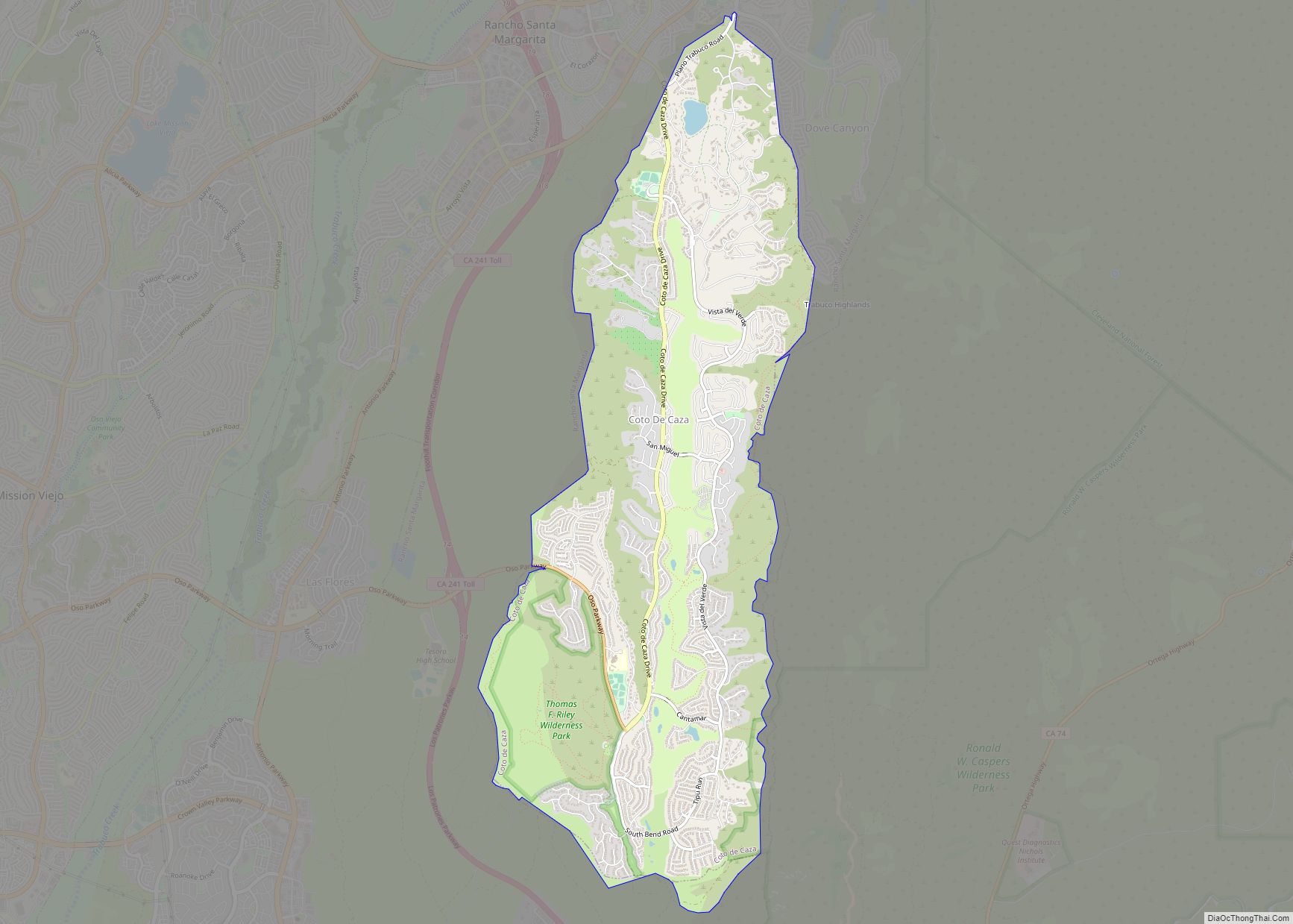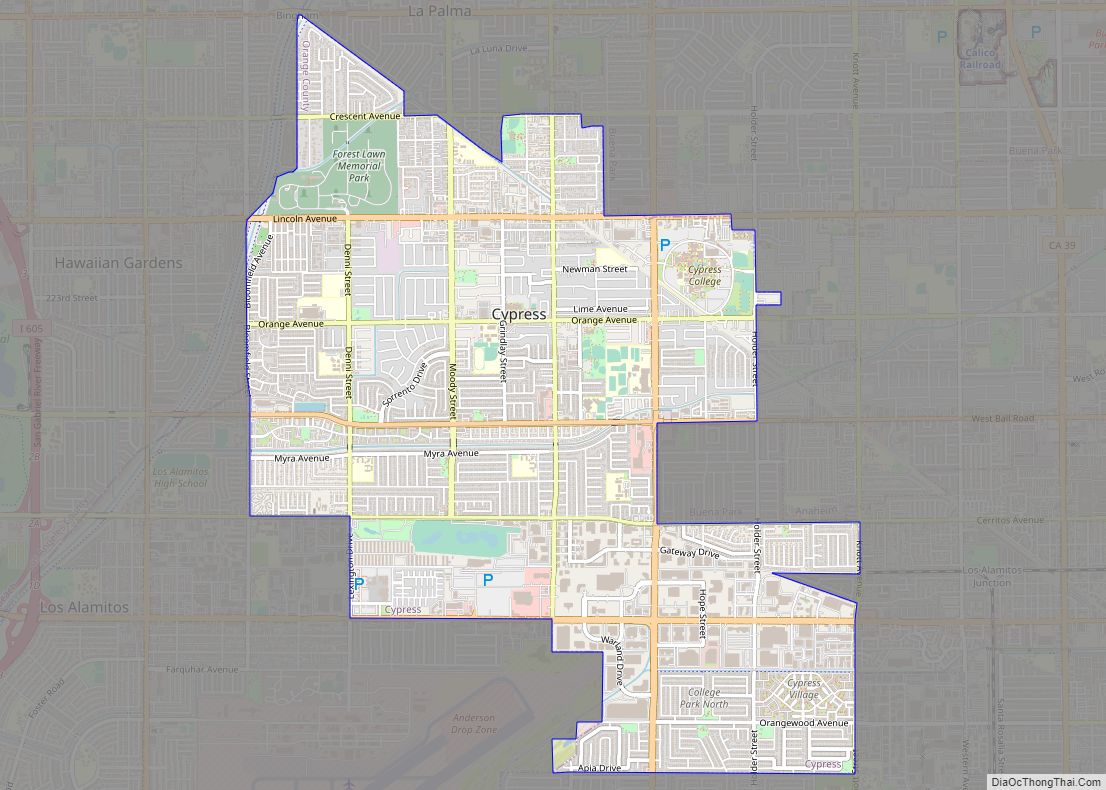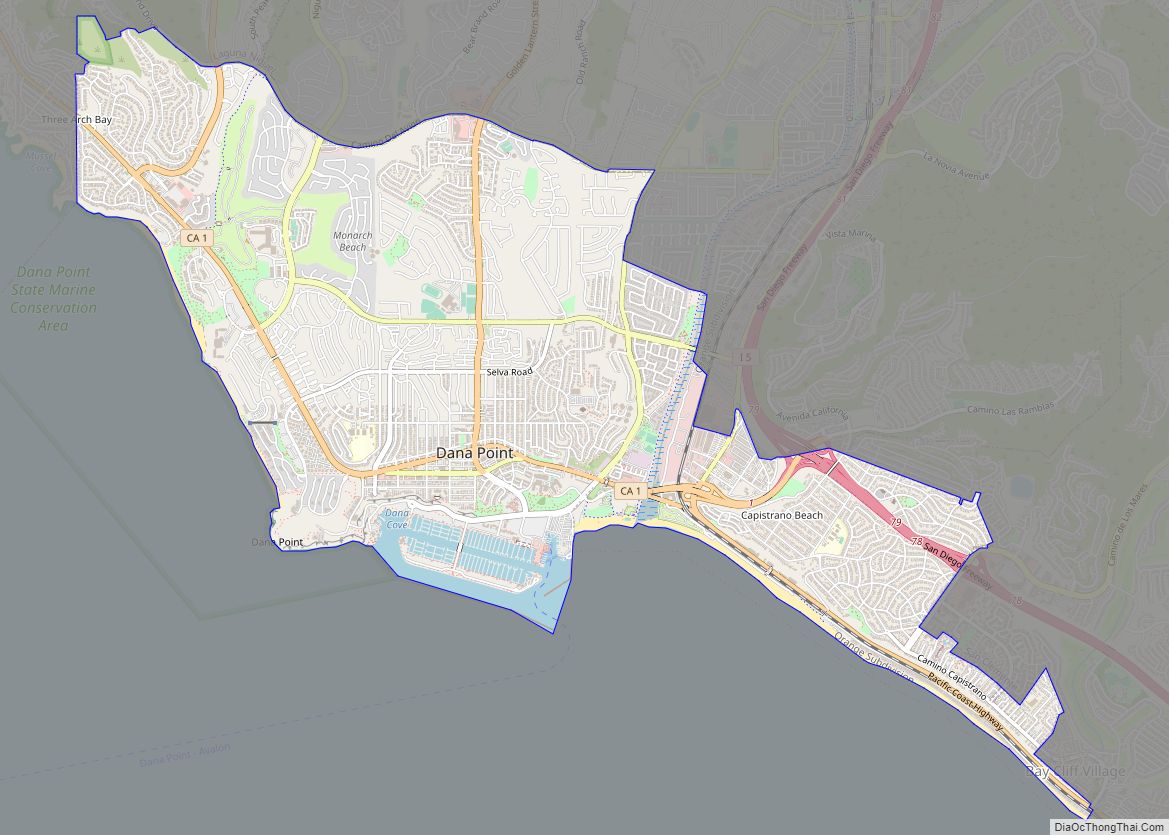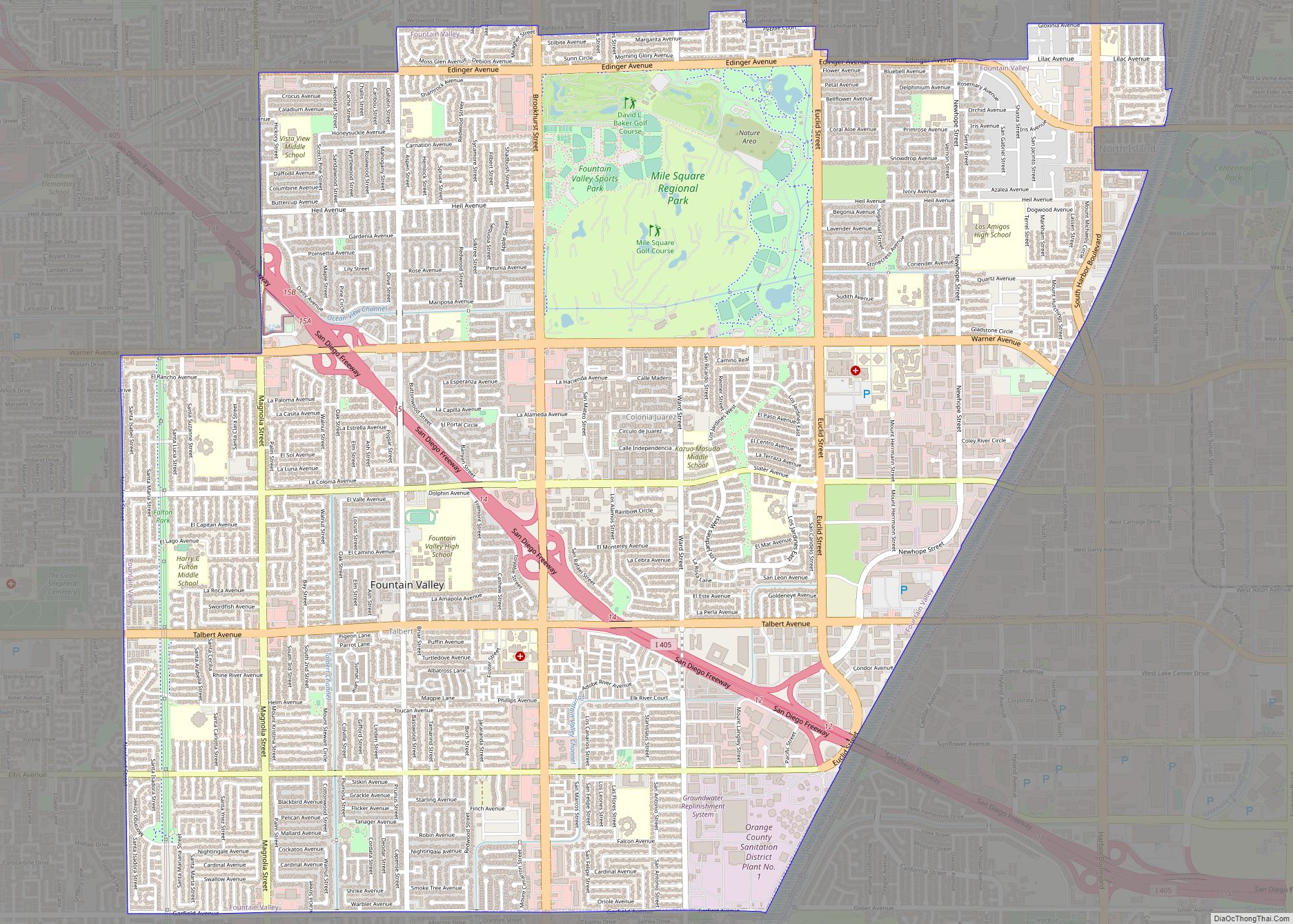Fullerton (/ˈfʊlərtən/ FUUL-ər-tən) is a city located in northern Orange County, California, United States. As of the 2020 census, the city had a total population of 143,617.
Fullerton was founded in 1887. It secured the land on behalf of the Atchison, Topeka and Santa Fe Railway. Historically it was a center of agriculture, notably groves of Valencia oranges and other citrus crops; petroleum extraction; transportation; and manufacturing. It is home to numerous higher educational institutions, particularly California State University, Fullerton and Fullerton College. From the mid-1940s through the late 1990s, Fullerton was home to a large industrial base made up of aerospace contractors, canneries, paper products manufacturers, and is considered to be the birthplace of the electric guitar, due in large part to Leo Fender. The headquarters of Vons, which is owned by Albertsons, is located in Fullerton near the Fullerton–Anaheim line.
| Name: | Fullerton city |
|---|---|
| LSAD Code: | 25 |
| LSAD Description: | city (suffix) |
| State: | California |
| County: | Orange County |
| Incorporated: | February 15, 1904 |
| Elevation: | 164 ft (50 m) |
| Total Area: | 22.44 sq mi (58.11 km²) |
| Land Area: | 22.42 sq mi (58.07 km²) |
| Water Area: | 0.01 sq mi (0.03 km²) 0.05% |
| Total Population: | 143,617 |
| Population Density: | 6,411/sq mi (2,475/km²) |
| FIPS code: | 0628000 |
| Website: | www.cityoffullerton.com |
Online Interactive Map
Click on ![]() to view map in "full screen" mode.
to view map in "full screen" mode.
Fullerton location map. Where is Fullerton city?
History
Indigenous
Evidence of prehistoric animal habitation, such as saber-toothed cats and mammoths, is present in Ralph B. Clark Regional Park in the northwest of the city.
The area of the city was a part of the homelands of the Tongva for thousands of years. There was a large village in the area along the Santa Ana River that has since been identified as the Hutuknga. The village was one of the largest throughout all of Tovaangar, or the Tongva world. It was connected by marriage ties to other villages in the area, including Genga. Acorns and seeds from grasses and sages were regularly cultivated. Trade connections were established with villages on the coast and those further inland.
Spanish era
Europeans first passed through the area in 1769 when Gaspar de Portolà led a Spanish expedition north to Monterey. From the description recorded in the diary of Father Juan Crespi, it seems likely that the party camped on July 29 near present-day Laguna Lake, in the Sunny Hills area.
In 1837, the Fullerton area became part of Rancho San Juan Cajón de Santa Ana, granted to Juan Pacifico Ontiveros, a Spanish soldier.
American era
Ontiveros began selling parcels of the Rancho to migrant Americans settling and developing California in the aftermath of the 1849 Gold Rush, including Abel Stearns. In the 1860s, Stearns sold in turn to Domingo Bastanchury, a Basque shepherd.
In 1886, while in the area on a duck hunting vacation, brothers George and Edward Amerige, heard rumors that the California Central Railroad, a subsidiary of the Santa Fe Railway, was looking for land. Sensing opportunity, they arranged to buy 430 acres (1.7 km) north of Anaheim for approximately $68,000. They then began negotiations with George H. Fullerton, president of the Pacific Land and Improvement Company, also a Santa Fe subsidiary. They offered free right-of-way and half interest in the land to the railroad if Fullerton’s survey were revised to include the proposed town site, and on July 5, 1887, Edward Amerige formally staked his claim at what is now the intersection of Harbor Boulevard and Commonwealth Avenue.
In 1894, Charles Chapman purchased an orange orchard in eastern Fullerton. The Valencia variety of oranges he promoted from his Santa Ysabel Ranch, well suited to the local climate, proved a boon to producers; Fullerton boasted more orange groves than any other municipality in the United States. Cultivation of walnuts and avocados also flourished, and the Western railroad town became an agricultural center. Fullerton was incorporated in 1904, but not officially recognized until 1907, due to conflicts at that time.
Boom years
Drilling for petroleum began in 1880 with the discovery of the Brea-Olinda Oil Field and fueled the first real boom, peaking in the 1920s. Construction reflected the vogue for Spanish Colonial and Italian Renaissance-inspired architecture, as in the historic Fox Fullerton Theatre (erected 1925); the Muckenthaler House, designed by Frank K. Benchley (erected 1924); and the city’s chief landmark, the Plummer Auditorium and clock tower (erected 1930). Fullerton College was established at its present location at Chapman Avenue and Lemon Street in 1913. Meanwhile, the city banned all overnight street parking in 1924 – a law enforced to the present day, unless an area is specifically exempted.
Significant public works projects from the interwar period were constructed during this period, including the conversion of a southwestern sewer farm into Fullerton Municipal Airport at the behest of Placentia ranchers and aviators William and Robert Dowling in 1927. Through the mid-1900s, the economy shifted toward food processing rather than food production, as well as manufacturing; southeastern Fullerton became an industrial center. Val Vita Food Products began operating a citrus juice plant in western Fullerton in 1932. By 1941, it had become the largest food processing company in the US. In 1934, A.W. Leo, Tom Yates and Ralph Harrison developed the first Hawaiian Punch recipe in a converted garage in Fullerton. The city also became a producer of aerospace equipment, electrical and electronic components, navigation systems, and laboratory instruments.
In 1943, the Alex Bernal residence became the site of one of the first successful lawsuits against household covenant laws in the country after Alex and Esther Bernal purchased a home in a Fullerton neighborhood that barred purchases from “Mexicans.” After a home invasion that resulted in their belongings being thrown into the street and a petition signed by fifty neighborhood residents to have the Bernal’s removed from the neighborhood, a lawsuit was issued against the Bernals on the basis that their presence caused “irreparable injury” to the neighborhood that could lead to “coming in contact with said other races, including Mexicans, in a social and neighborhood manner.” Lawyer David C. Marcus represented the Bernals in Doss vs. Bernal and won the case, which received national attention.
In 1949, Leo Fender developed and refined the world’s first commercially successful solid-body electric guitar, the Fender Telecaster.
Postwar suburbanization
Although Fullerton, like other Southern California cities, had experienced an expansion of population due to housing development, this increased by an order of magnitude during the post war years. Fullerton’s population soared after World War II as American veterans migrated to California, bought housing in the land development which destroyed the surrounding farming and park areas, and in particular after the construction of Interstate 5 and development in neighboring Anaheim.
To serve the growing population, the California State Legislature authorized Orange County State College in 1957, which began operating out of Fullerton high schools in 1959. In 1963, it moved to its present campus on State College Boulevard, and later, after several name-changes, was finally redesignated California State University, Fullerton. The Fullerton Arboretum, a 26-acre (105,000 m) botanical garden, opened in 1979.
Manufacturing growth leveled off as ever-soaring property prices, increasing environmental regulation, traffic, and other pressures increased. By the late 20th century the city had lost much of its rural character in favor of suburban housing tracts and shopping centers.
Recent history
In the 1990s, the downtown commercial district had become economically depressed, and was known mainly for being an area of sleepy antique stores and small shops. A symbol of downtown’s problems was the Fox Theatre, a local landmark, which had fallen into disrepair. As of November 2004, a fundraising drive had accumulated sufficient funds to buy the theater, but not yet enough money to restore it. By 2006, restoration was started.
During this same period, downtown Fullerton (DTF), especially in the south of Commonwealth area (SOCO), has become more of a busy entertainment district, described by the OC Weekly as “Bourbon Street West.” In less than five years, some 30 businesses that sell alcohol have opened, making the downtown area much more active at night. In 2008, City Manager Chris Meyer called together department head and the finance department and reported to the city council that the Restaurant Overlay District (established December 2002) was costing the city $935,000 over and above the sales taxes collected.
The 293-acre (1.19 km) Hughes Aircraft Company’s Ground Systems Group campus in western Fullerton was redeveloped into a new residential and commercial district called Amerige Heights, in between 2001 and 2004.
Fullerton Road Map
Fullerton city Satellite Map
Geography
Fullerton is located at 33°52′48″N 117°55′43″W / 33.88000°N 117.92861°W / 33.88000; -117.92861 (33.879914, -117.928749). It is approximately 25 miles (40 km) southeast of downtown Los Angeles, and approximately 11 miles (18 km) north-northwest of Santa Ana, the county seat. The city has a mean elevation of 150 feet (46 m) and lies approximately 11 miles (18 km) northeast of the Pacific Ocean straight-line distance. It has a Mediterranean climate, with a mean temperature of 62.2 °F (16.8 °C).
According to the United States Census Bureau, the city has a total area of 22.4 square miles (58 km), of which 22.4 square miles (58 km) is land and 0.01 square miles (0.026 km), comprising 0.05%, is water.
It is bordered by La Habra and Brea on the north, La Mirada on the northwest, Buena Park on the west, Anaheim on the south, and Placentia on the east.
The flat downtown area is laid out in a grid plan centered at the intersection of Harbor Boulevard and Commonwealth Avenue. After recent renewal and beautification projects, it has attracted specialty stores, coffee shops, and restaurants, and has uncharacteristically retained much of its downtown character. Southeastern Fullerton is historically the industrial sector, and is home to small manufacturing, particularly east of Raymond Street and south of Commonwealth.
The northern and western reaches of Fullerton are dominated by the Coyote Hills, a low-lying mountain range divided into the East Coyote Hills and West Coyote Hills. The land south of West Coyote Hills is known as Sunny Hills. For most of the city’s history these areas were groves of citrus trees, open scrubland, and oil fields. While equestrian trails and many old estates endure along Bastanchury Road, the meandering roads through these areas today mostly connect a succession of housing tract subdivisions and commercial developments. In recent years, the city council has tried to allow development in the remaining open land throughout the city. The most notable impending project, in West Coyote Hills, has been met with opposition by many of the citizens in the area.
Development of West Coyote Hills
West Coyote Hills is a ridge lying mostly in northern Fullerton, including 510 acres (206 ha) owned by Pacific Coast Homes (a land development division of the Chevron Corporation) that are the largest remaining tract of undeveloped land in north Orange County. The current development agreement calls for building houses on some of the land while donating the remainder to the city as a nature preserve. A group that supports keeping the entire area as open space/nature preserve qualified a referendum for a November 2012 election. In the election, voters approved Measure W, which would prevent development in the area. Ongoing lawsuits between the City of Fullerton (pro-development) and local conservationists (anti-development) have resulted over the interpretation of the measure. In February 2019, the California State Supreme Court denied a petition to review a lower court pro-development decision against Measure W. The City of Fullerton and The Friends of Coyote Hills are currently in competing negotiations with Chevron over either purchasing the land for development or donating the land for conservation with Chevron receiving tax credits and conservation funds in exchange for the donation.
Climate
According to the Köppen Climate Classification system, Fullerton has a warm-summer Mediterranean climate, abbreviated Csa on climate maps.
Parks
Fullerton maintains more than 50 city parks and is home to Hillcrest Park, Chapman Park, and the Orange County Regional parks Craig Regional Park and Ralph B. Clark Regional Park (in neighboring Buena Park, although a small portion lies within Fullerton city limits). The Fullerton Arboretum comprises 26 acres (11 ha) (105,000 m) of sculpted gardens and unusual plants in northeastern Fullerton. Additionally, the city features approximately 200 acres (0.81 km) of recreational land in the Brea Dam Recreational Area, plus an equestrian center and trails, two golf courses, a sports complex located southeast of St. Jude Medical Center Hospital and the Janet Evans swim Complex.
The Fullerton city council voted on November 15, 2019 to proceed with work on a concept plan for a memorial to Korean War veterans at Hillcrest Park. The project will be funded and developed by The Orange County Korean War Memorial Committee.
See also
Map of California State and its subdivision:- Alameda
- Alpine
- Amador
- Butte
- Calaveras
- Colusa
- Contra Costa
- Del Norte
- El Dorado
- Fresno
- Glenn
- Humboldt
- Imperial
- Inyo
- Kern
- Kings
- Lake
- Lassen
- Los Angeles
- Madera
- Marin
- Mariposa
- Mendocino
- Merced
- Modoc
- Mono
- Monterey
- Napa
- Nevada
- Orange
- Placer
- Plumas
- Riverside
- Sacramento
- San Benito
- San Bernardino
- San Diego
- San Francisco
- San Joaquin
- San Luis Obispo
- San Mateo
- Santa Barbara
- Santa Clara
- Santa Cruz
- Shasta
- Sierra
- Siskiyou
- Solano
- Sonoma
- Stanislaus
- Sutter
- Tehama
- Trinity
- Tulare
- Tuolumne
- Ventura
- Yolo
- Yuba
- Alabama
- Alaska
- Arizona
- Arkansas
- California
- Colorado
- Connecticut
- Delaware
- District of Columbia
- Florida
- Georgia
- Hawaii
- Idaho
- Illinois
- Indiana
- Iowa
- Kansas
- Kentucky
- Louisiana
- Maine
- Maryland
- Massachusetts
- Michigan
- Minnesota
- Mississippi
- Missouri
- Montana
- Nebraska
- Nevada
- New Hampshire
- New Jersey
- New Mexico
- New York
- North Carolina
- North Dakota
- Ohio
- Oklahoma
- Oregon
- Pennsylvania
- Rhode Island
- South Carolina
- South Dakota
- Tennessee
- Texas
- Utah
- Vermont
- Virginia
- Washington
- West Virginia
- Wisconsin
- Wyoming
